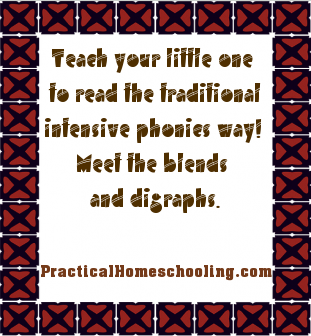 Few children have problems blending the letter sounds. They do it automatically in speech, even though they don't know that they are blending sounds together. It took a great linguistic genius way back when the alphabet was invented to break up the consonant blends into their separate sounds. But that became easy to do with the alphabet letters representing each irreducible speech sound. And today, it's easy for a child to learn by showing that the blends consist of separate sounds "blended" together.
Few children have problems blending the letter sounds. They do it automatically in speech, even though they don't know that they are blending sounds together. It took a great linguistic genius way back when the alphabet was invented to break up the consonant blends into their separate sounds. But that became easy to do with the alphabet letters representing each irreducible speech sound. And today, it's easy for a child to learn by showing that the blends consist of separate sounds "blended" together.
When to Teach Blends
When should you teach the blends? You can start after the child has learned the short-vowel sounds, all of the consonants, and can read many simple three-letter words. But before you go into the blends, you should teach the consonant digraphs - the two-letter combinations that stand for one sound - such as th, sh, ch - so that the child can read such words as wish, rich, the, that, this, with, etc. You can begin teaching the blends before you even teach the long vowels. In fact, I highly recommend teaching the blends entirely with short-vowel words because they are easier to learn with what has already been mastered.
Final Consonant Blends First
I teach the final consonant blends first, because words like and and end lead the child directly into learning the rhyming words in these spelling families. Thus, with and, you can teach band, hand, land, sand, wand. Note that wand has an irregular pronunciation in that spelling family. With end, the child can learn bend, fend, lend, mend, rend, send, tend, wend. Then teach ng so that the child can separate the two sounds into n and g, blend them together, and learn to read such words as bang, rang, sang, sing, king, song, sung, etc. The child can then read such sentences as Bob sang a song in Hong Kong.
With the ng you can teach a whole slew of words with ing endings: picking, rocking, chilling, ringing, sunning, fishing, passing, fixing, etc. In other words, when you teach the blends you increase the child's reading vocabulary tremendously. Teach the rest of the blends: nt as in sent, nk as in ink, nch as in lunch, nc as in zinc, ct as in fact, ft as in lift, pt as in wept, xt as in next, sk as in ask, sp as in lisp, st as in fast, lb as in bulb, ld as in held, lf as in self, lk as in milk, lm as in elm, lp as in help, lt as in felt, mp as in jump, tch as in match, dge as in fudge, nge as in tinge, nce as in dance, nse as in dense.
Initial Blends Next
Then teach the initial blends: bl, br, cl, cr, dr, dw, fl, fr, gl, gr, gw, pl, pr, sl, shr, sm, sn, sp, spl, spr, st, str, sw, sc, sk, scr, tr, thr, tw. That will permit the child to reach such words as blend, bliss, bring, brush, clam, clinch, crab, crop, drag, drift, dwell, flag, fling, fresh, glad, grill, plan, plump, prank, prince, slant, slept, shrank, smell, sniff, spent, spot, stack, stilt, stump, strap, swept, scan, skill, script, track, throb, twelve.
Note that some of the blends consist of three sounds as in s-t-r-ap and s-c-r-ipt. It is by learning the blends that a child really learns how ingenious the alphabet is in permitting us to break up the blends into their separate irreducible sounds.
Now... Long Vowels
After teaching the blends, then teach the long vowels. The big problem with the long vowels is that they have more than one spelling form. For example, long a is spelled with simple a as in such words as apron and April. It is also spelled a-consonant-e, as in ate, bake, face. It is also spelled ai as in aid, aim, rain, snail, wait. It is also spelled ay as in day, stay, play, may. It is also spelled as ei as in vein, rein, veil. And finally it is also spelled eigh as in weigh, eight, freight. In other words, we have six different spelling forms for long a. That accounts for our spelling problem. Besides learning letter sounds it is also important to learn spelling forms.
We have the same problem with long e, long i, long o, and long u: a variety of spellings for the same sound. And that is why I recommend the sequence of teaching outlined above.
Incidentally, one of the reasons why we have more than one spelling for the same sound is because we have many words that sound alike but have different meanings. For example made and maid sound alike, but their spelling indicates the meaning we wish to convey. The same is the case with rain and rein, or weigh and way. In other words, our variety of spellings permits us to make versatile use of our magnificent alphabetic system.